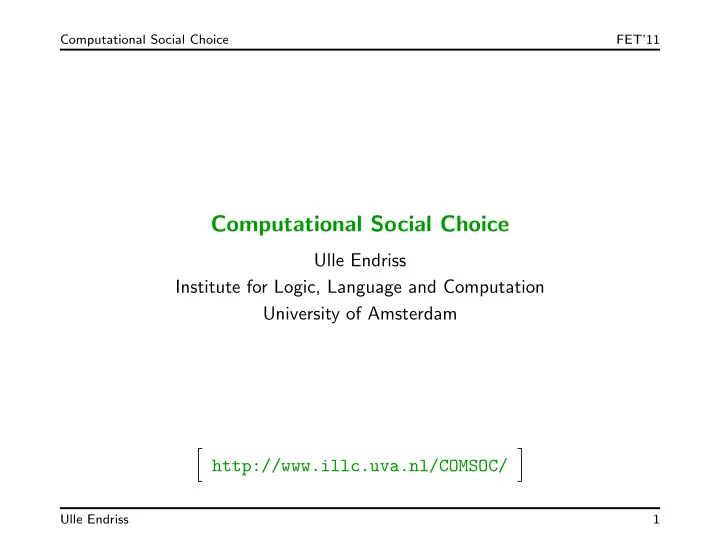

Computational Social Choice FET’11 Computational Social Choice Ulle Endriss Institute for Logic, Language and Computation University of Amsterdam � � http://www.illc.uva.nl/COMSOC/ Ulle Endriss 1
Computational Social Choice FET’11 Classic Example: The Condorcet Paradox Social Choice Theory asks: how should we aggregate the preferences of the members of a group to obtain a “social preference”? Expert 1: ≻ ≻ Expert 2: ≻ ≻ Expert 3: ≻ ≻ Expert 4: ≻ ≻ Expert 5: ≻ ≻ Marie Jean Antoine Nicolas de Caritat (1743–1794), bet- ter known as the Marquis de Condorcet : Highly influen- tial Mathematician, Philosopher, Political Scientist, Politi- cal Activist. Observed that the majority rule may produce inconsistent outcomes (“Condorcet Paradox”). Ulle Endriss 2
Computational Social Choice FET’11 Classic Result: Arrow’s Impossibility Theorem In 1951, K.J. Arrow published his famous Impossibility Theorem: Any preference aggregation mechanism for three or more alternatives that satisfies the axioms of unanimity and IIA must be dictatorial . • Unanimity: if everyone says A ≻ B , then so should society. • Independence of Irrelevant Alternatives (IIA): if society says A ≻ B and someone changes their ranking of C , then society should still say A ≻ B . Kenneth J. Arrow (born 1921): American Economist; Pro- fessor Emeritus of Economics at Stanford; Nobel Prize in Economics 1972 (youngest recipient ever). His 1951 PhD thesis started modern Social Choice Theory. Google Scholar lists 9897 citations of the thesis. Ulle Endriss 3
Computational Social Choice FET’11 Modern Applications of Social Choice Theory Social choice-like problems arise in many applications. Examples: • Job Markets: allocate junior doctors to hospitals, etc. • Search Engines: determine the most important sites based on links (“votes”) + to aggregate the output of several search engines • Semantic Web: aggregate information from distinct sources in a consistent manner • Others: grid computing, e-governance, e-commerce, live organ exchange, social networks, recommender systems, . . . But not all of the classical assumptions will fit these new applications. So we need to develop new models and ask new questions . Ulle Endriss 4
Computational Social Choice FET’11 Computational Methods in Social Choice Vice versa , techniques from computer science are useful for advancing the state of the art in social choice. Examples: • Algorithms and Complexity: to develop algorithms for (complex) voting procedures + to understand the hardness of “using” them • Knowledge Representation: to compactly represent the preferences of individual agents over large spaces of alternatives • Logic and Automated Reasoning: to formally model problems in social choice + to automatically verify (or discover) theorems Ulle Endriss 5
Computational Social Choice FET’11 Session Overview Computational Social Choice = looking at social choice through the “computational lens”, aiming for (computational) applications Rest of the programme: (1) Britta Dorn (Ulm) Multivariate Algorithmics for Voting (2) J´ erˆ ome Lang (Paris) Voting in Combinatorial Domains (3) Ioannis Caragiannis (Patras) Computational Challenges in Fair Division (4) Francesca Rossi (Padova) Automated Design of Social Choice Mechanisms (5) P´ eter Bir´ o (Budapest) Matching Schemes in Practice Ulle Endriss 6
Recommend
More recommend